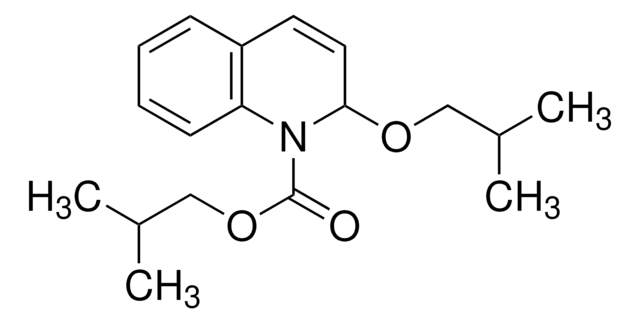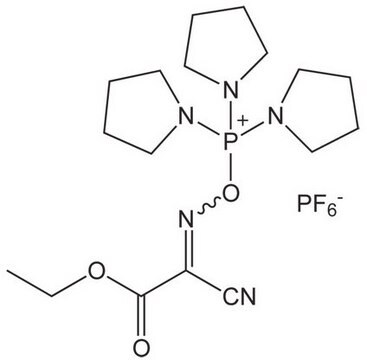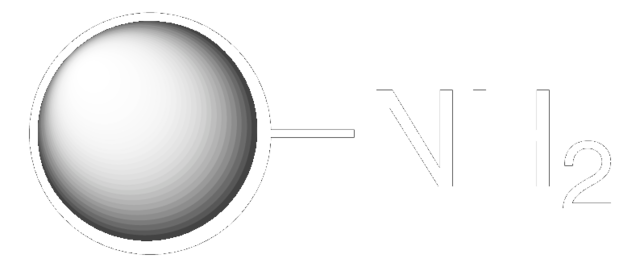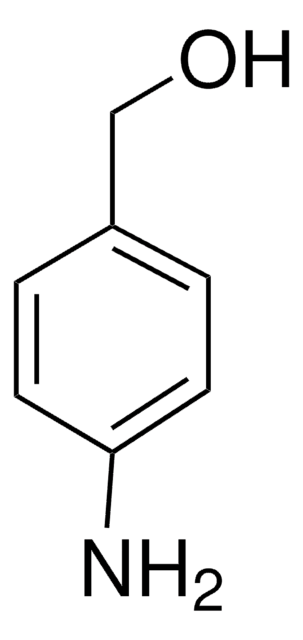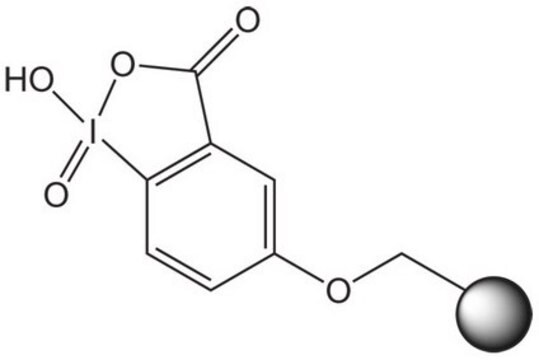About This Item
Kod UNSPSC:
13111023
Polecane produkty
Poziom jakości
linia produktu
Novabiochem®
Postać
beads
przydatność reakcji
reaction type: solution phase peptide synthesis
producent / nazwa handlowa
Novabiochem®
Zastosowanie
peptide synthesis
temp. przechowywania
2-8°C
Powiązane kategorie
Opis ogólny
IIDQ-polystyrene (IIDQ-PS) [1] is a polymer-supported version of the IIDQ coupling reagent [2]. IIDQ has many advantages over conventional carbodiimide- or uronium-based reagents: no preactivation step is required, and acid, amine and coupling reagent can be added in any order; in contrast to uronium-based reagents like HBTU, it cannot form guanidinium by-products; and it is totally stable to base. The treatment of a carboxylic acid with IIDQ-PS in DCM or MeCN rapidly generates in situ the corresponding isobutoxycarbonyl mixed anhydride [3]. Attack by nucleophiles preferentially takes place at the less hindered and more electrophilic carbonyl of the carboxylic acid moiety, releasing only volatile carbon dioxide and isobutanol as by-products. If reaction is carried out in the presence of an amine, amide bond formation occurs concurrently with generation of the anhydride. Alternatively, addition of NaBH4 or polymer-supported borohydride to the anhydride will lead directly to the corresponding alcohol. IIDQ-PS appears to be particularly effective for mediating the acylation for anilines, and has also been found to couple peptide fragments without epimerization. In a comparative study, IIDQ-PS was found to give higher yields and greater purities than HATU, EDC-PS or DCC-PS [4]. Occasionally, with some secondary amines the formation of isobutyl carbamate by-products has been observed, resulting from attack by the amine at the carbonyl group.
Literature references
[1] E. Valeur, et al. (2005) Chem. Commun., 1164.
[2] Y. Kiso, et al. (1973) Chem. Pharm. Bull., 21, 2507.
[3] J. R. Vaughan (1951) J. Am. Chem. Soc., 73, 3547.
[4] E. Valeur & M. Bradley, unpublished results.
Literature references
[1] E. Valeur, et al. (2005) Chem. Commun., 1164.
[2] Y. Kiso, et al. (1973) Chem. Pharm. Bull., 21, 2507.
[3] J. R. Vaughan (1951) J. Am. Chem. Soc., 73, 3547.
[4] E. Valeur & M. Bradley, unpublished results.
Powiązanie
Replaces: 01-64-0469
Komentarz do analizy
Color (visual): yellow to beige to amber
Appearance of substance (visual): beads
Loading (determined by HPLC after reaction of 3-phenylpropionic acid with cyclohexlamine): 1.3 - 1.9 mmol/g
Swelling Volume (in DMF): lot specific result
The polymer matrix is copoly (styrene-1 % DVB) 200 - 400 mesh.
Appearance of substance (visual): beads
Loading (determined by HPLC after reaction of 3-phenylpropionic acid with cyclohexlamine): 1.3 - 1.9 mmol/g
Swelling Volume (in DMF): lot specific result
The polymer matrix is copoly (styrene-1 % DVB) 200 - 400 mesh.
Informacje prawne
Novabiochem is a registered trademark of Merck KGaA, Darmstadt, Germany
This page may contain text that has been machine translated.
Kod klasy składowania
11 - Combustible Solids
Klasa zagrożenia wodnego (WGK)
WGK 1
Temperatura zapłonu (°F)
Not applicable
Temperatura zapłonu (°C)
Not applicable
Certyfikaty analizy (CoA)
Poszukaj Certyfikaty analizy (CoA), wpisując numer partii/serii produktów. Numery serii i partii można znaleźć na etykiecie produktu po słowach „seria” lub „partia”.
Masz już ten produkt?
Dokumenty związane z niedawno zakupionymi produktami zostały zamieszczone w Bibliotece dokumentów.
Nasz zespół naukowców ma doświadczenie we wszystkich obszarach badań, w tym w naukach przyrodniczych, materiałoznawstwie, syntezie chemicznej, chromatografii, analityce i wielu innych dziedzinach.
Skontaktuj się z zespołem ds. pomocy technicznej

